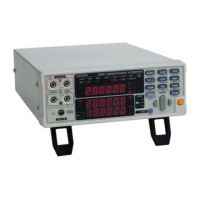Appendix 2 Temperature Correction Function (TC)
170
Temperature correction employs the temperature coefficient of a
material to convert its resistance measured at one temperature to the
value it would have at any other temperature, for display. Because
resistance is fundamentally temperature-dependent, measuring it
without considering the temperature can provide meaningless results.
Resistances R
t
and R
t0
below are the resistance values of the test
object (having resistance temperature coefficient at t
0
°C of α
t0
) at t°C
and t
0
°C.
Example If a copper test object (with resistance temperature coefficient of 3930
ppm) measures 100 Ω at 30°C, its resistance at 20°C is calculated as
follows:
Refer to the following for temperature correction settings and
execution method:
❖ Making Temperature Correction Settings (Reference Temperature and
Temperature Coefficient) (Page 58)
❖ Enabling/Disabling Temperature Correction (Page 59)
❖ Reference (Page 171)
Appendix 2 Temperature Correction
Function (TC)
R
t
R
t0
1 α+
t0
tt
0
–()×{}×=
R
t
Actual measured resistance [Ω]
R
t0
Corrected resistance [Ω]
t
0
Reference temperature [°C]
t Ambient temperature [°C]
α
t0
Temperature coefficient at t
0
[1/°C]
100
1 3930 10
6–
×()30 20–()×+
------------------------------------------------------------------------=
96.22=
R
t0
R
1
1 α
t0
tt
0
–()×+
----------------------------------------=
• The temperature probe detects only ambient temperature; not
surface temperature.
• Before measuring, allow the instrument and temperature probe to
warm up completely, place the temperature probe as close to the
test object as possible, and allow sufficient time for them to
stabilize at ambient temperature.

